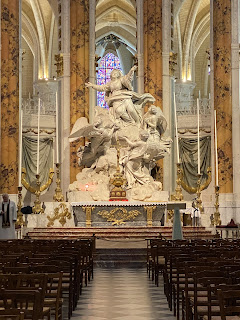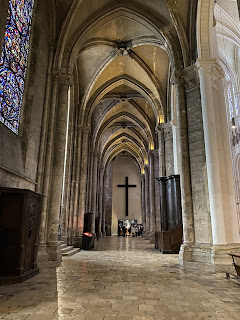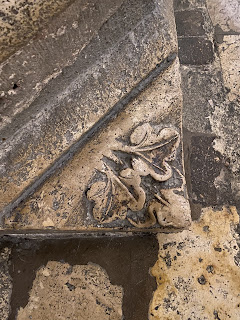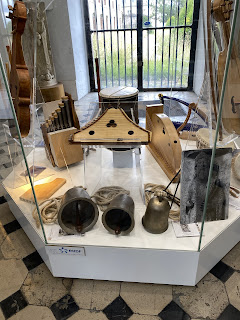In 1995 I attended the Hospice Care Conference in San Francisco as the Spiritual Care Coordinator for Hospice Care of Pittsburgh where I’d been working for a short period of time. I had just left parish ministry; something that I’d trained for, studied for, and spent a huge amount of time investing in as my vocation. And I was trying something different with hospice work, trying to find where in ministry I belonged, what was supposed to be my “calling”. After the conference, I’d attached a few days of vacation on to the trip in order to see more of San Francisco and the West Coast. One of my “hobbies” has always been to take photographs of churches and other spiritual places of worship. While in San Francisco I came across Grace Cathedral, an Episcopalian Church. It was open, so I went inside. At the back of the church I noticed a number of people walking along a maze that was on the floor. I stood watching as people took off their shoes and walked inside. I could see that there was a round open center. Not knowing much more, I also took off my shoes and kind of hopped inside walking around the path in front of me. Within moments I was on a path that led to the exit without ever having arrived at the center. Knowing that I hadn’t “done it right”, I felt rather foolish and embarrassed and just put my shoes back on and left. I went outside and began walking away. The mental calisthenics that took over is something that I don’t like to relive. I have a lot of conversations with myself - sometimes ones that lead you down dark journeys of questioning everything; who you are, what purpose you serve, why you even bother, about failure and disappointment. The voice that shouted in the back of my head at the time was, “you can’t even walk a simple maze right, no wonder you don’t know where you belong in ministry.” After a long few moments, I went back inside and watched a bit more. I realized then that where I had exited was where people were entering. I started over. My mind raced, as always, during the first part of walking it - thinking about all kinds of useless and important things that go through a person’s mind when they aren’t completely engaged in something else. About halfway through, the mind focuses and the rhythm changes. About three-quarters of the way to the center, you notice your breathing and the rhythm of your heart. By the time you get to the center, your mind is clear and you are more fully aware of yourself, if nothing else.
I later learned that this maze on the floor at Grace Cathedral is not a maze, but is called a labyrinth and that Dr. Lauren Artress brought the design of the labyrinth to Grace Cathedral from its original location of Chartres Cathedral in France which was designed into the marble floor of the church when it was built in the beginning of the 13th Century. The difference between a maze and a labyrinth is that a maze has no structured path, the paths lead willy-nilly wherever, sometimes into dead ends, while a labyrinth is designed to lead in a continuous path in only one direction. I have walked a copy of the labyrinth several times in various locations and have read Dr. Artress’s book called, Walking a Sacred Path. Each walk has shown me different lessons. The most profound lesson came the third time I walked the labyrinth; it’s personal and difficult to describe, but I came to a fuller understanding of who I am, what makes me - me, and the surprising inner conflict this has always created in me. I’ve walked the labyrinth in Juneau, Alaska, at Camp Crestfield, and at East Liberty Presbyterian Church. My desire has always been to walk the original labyrinth in Chartres Cathedral. Every Friday the chairs are removed and people are welcome to walk the Chartres Cathedral Labyrinth as they wish, so I’m here to walk the original labyrinth tomorrow morning. I’ll talk a little bit more about the labyrinth in my blog tomorrow, but for now here are some pictures of the Chartres Cathedral Church.
Since 2016, the church has been undergoing a serious renovation. The type of renovation they are doing is quite controversial. As the centuries have passed, these ancient limestone or soft marble pillars wear away. They are trying to recreate the look and feel of the old pillars and other ornamentals using modern material and equipment. Some see this as a wonderful way to preserve and restore what something used to look like, others see it as a fake misrepresentation of what is no longer real - I’ve posted a picture down below of one of the columns they are remaking.
Here is an instance where I’d love to talk about this with my sister. She was passionate about the restoration of history - having spent her entire career with the National Park Service, particularly in the National Historical Parks. She would definitely have a thing or two to say about this. Knowing her passion about this, she and I may have fallen in two different camps, but I’d love to hear her arguments.
After visiting the Cathedral I went to the Art Museum. It’s really nothing special, but the building itself had been the home of the Bishop and is known as the Ecclesiastical Palace.



















































No comments:
Post a Comment